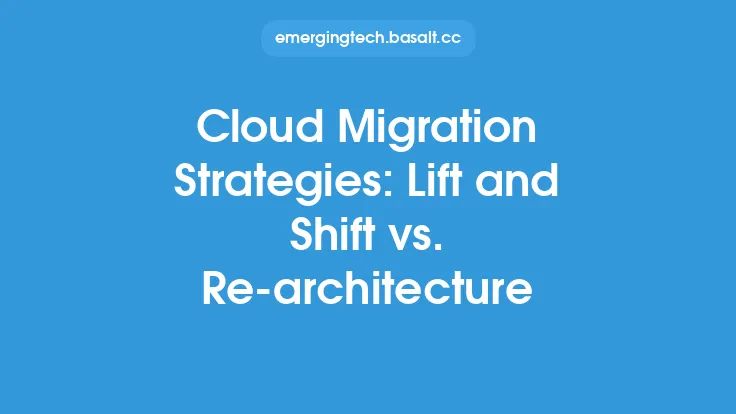Cloud networking is a crucial aspect of cloud computing, enabling the creation of a network infrastructure that is scalable, flexible, and on-demand. At its core, cloud networking involves the design, implementation, and management of networks that operate within cloud computing environments. This includes the use of virtualized network resources, such as virtual local area networks (VLANs), virtual private networks (VPNs), and virtual network functions (VNFs). In this article, we will delve into the fundamentals of cloud networking, exploring its architecture and design principles.
Introduction to Cloud Networking Architecture
Cloud networking architecture refers to the overall design and structure of a cloud network. It encompasses the various components, including physical and virtual network devices, network services, and management systems. A well-designed cloud networking architecture is essential for ensuring the reliability, security, and performance of cloud-based applications and services. The architecture should be able to support the dynamic provisioning and de-provisioning of network resources, as well as the integration of multiple cloud services and applications.
Cloud Networking Design Principles
When designing a cloud network, there are several key principles to consider. First and foremost, the network should be highly available and resilient, with built-in redundancy and failover capabilities to minimize downtime and ensure continuous operation. The network should also be scalable, able to adapt to changing demands and workloads without compromising performance. Additionally, the network should be secure, with robust security measures in place to protect against unauthorized access and malicious activity. Finally, the network should be manageable, with intuitive tools and interfaces for monitoring, troubleshooting, and optimizing network performance.
Virtual Network Components
Virtual network components are a critical aspect of cloud networking, enabling the creation of virtual networks that are isolated from the underlying physical infrastructure. These components include virtual switches, virtual routers, and virtual firewalls, which can be used to create complex network topologies and architectures. Virtual network components can be provisioned and de-provisioned on-demand, allowing for greater flexibility and agility in the deployment of cloud-based applications and services.
Network Virtualization
Network virtualization is a key technology that enables the creation of virtual networks in cloud computing environments. It involves the use of software to create virtual network devices and services, which can be used to create multiple virtual networks on top of a single physical network infrastructure. Network virtualization provides a number of benefits, including improved network utilization, increased flexibility, and enhanced security. It also enables the creation of virtual network functions, such as virtual firewalls and virtual load balancers, which can be used to provide advanced network services.
Cloud Network Topologies
Cloud network topologies refer to the physical and logical arrangement of network devices and connections within a cloud computing environment. There are several common cloud network topologies, including hub-and-spoke, mesh, and hybrid topologies. The choice of topology will depend on the specific requirements of the cloud-based application or service, as well as the underlying network infrastructure. A well-designed cloud network topology is essential for ensuring the reliability, security, and performance of cloud-based applications and services.
Cloud Networking Services
Cloud networking services refer to the various services and functions that are provided by cloud networking architectures. These services include network connectivity, network security, and network management, as well as advanced services such as load balancing, content delivery, and network optimization. Cloud networking services can be provided by cloud service providers, or they can be deployed on-premises using cloud networking equipment and software.
Cloud Network Security
Cloud network security is a critical aspect of cloud computing, as it involves the protection of cloud-based applications and services from unauthorized access and malicious activity. Cloud network security measures include firewalls, intrusion detection and prevention systems, and encryption, as well as advanced security services such as threat intelligence and security analytics. A well-designed cloud network security architecture is essential for ensuring the confidentiality, integrity, and availability of cloud-based applications and services.
Cloud Networking Management
Cloud networking management refers to the processes and tools used to monitor, troubleshoot, and optimize cloud network performance. This includes network monitoring and analytics, as well as configuration management and change management. Cloud networking management tools can be used to provide real-time visibility into network performance, as well as to automate network configuration and troubleshooting tasks. A well-designed cloud networking management system is essential for ensuring the reliability, security, and performance of cloud-based applications and services.
Best Practices for Cloud Networking
When designing and implementing a cloud network, there are several best practices to consider. First and foremost, the network should be designed with security and compliance in mind, with robust security measures in place to protect against unauthorized access and malicious activity. The network should also be designed with scalability and flexibility in mind, with the ability to adapt to changing demands and workloads without compromising performance. Additionally, the network should be designed with manageability in mind, with intuitive tools and interfaces for monitoring, troubleshooting, and optimizing network performance. Finally, the network should be designed with reliability and availability in mind, with built-in redundancy and failover capabilities to minimize downtime and ensure continuous operation.





